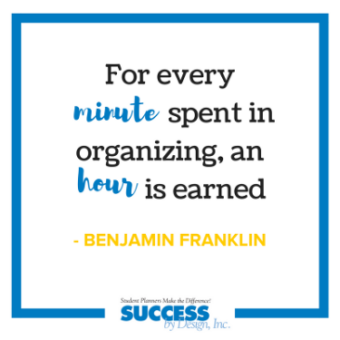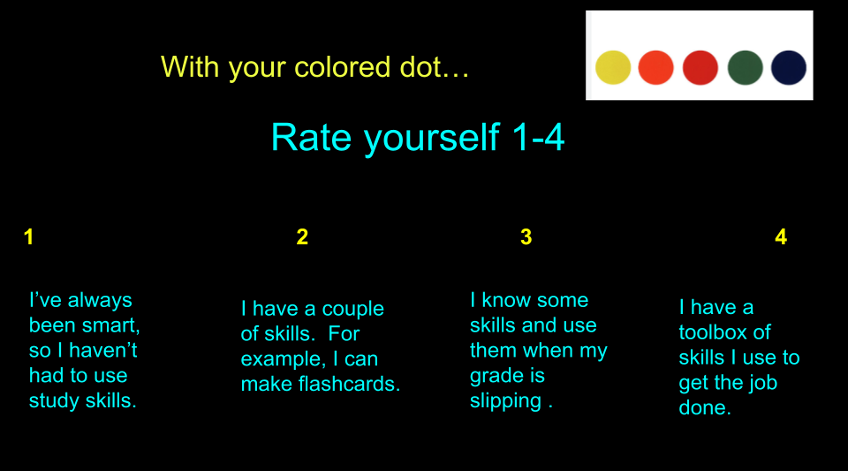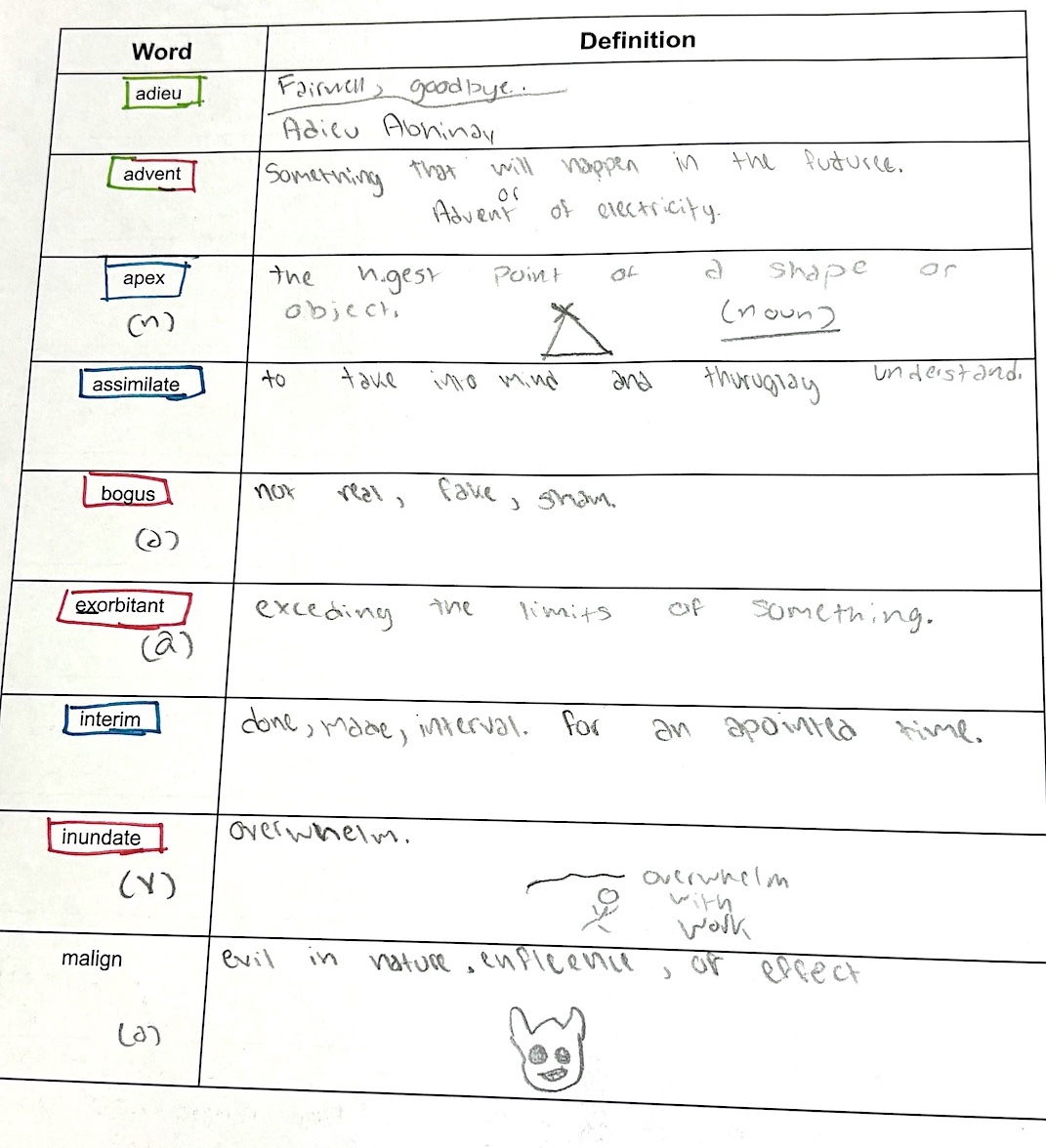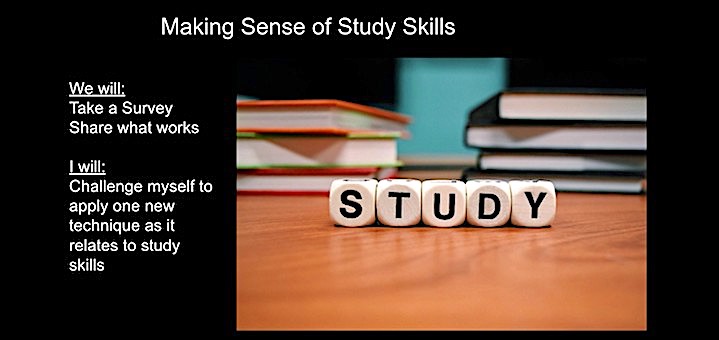Teaching Study Skills Middle Schoolers Need
By Sharon D. Ratliff

Ricky: “Mrs. R, I know… I know I need to study.” Ricky pulled out his jumbled notes and half-completed maps and blinked bewilderedly.
“Elementary school was so much easier,” he sighed.
Flummoxed (Ricky was an advanced reader and in GT classes), I pondered his situation. The mess that was Ricky’s backpack was living proof that every student needs to have an organizational system along with study skills to ensure optimal learning.
Without these tools, success in school is like a lottery. Students are trying to blindly build their understanding and knowledge in the hopes of achieving success, but many times they are stumbling by with a mediocre understanding of the material.
Here’s how I supported Ricky. Feel free to share some of these tips with Rickys of your own!
Part One – Organization
1) Handwritten Notes/Handouts: Although many materials are digital, students still have papers to manage and hard copies of notes. To orchestrate organization, have students designate folders/spirals/or a divided binder for core subjects. Work that needs to be completed pronto can be set apart in a red folder to signal “Attention!”
One sixth-grade teacher I know conducts weekly or bimonthly “organizational checks.” She says these checks keep students accountable and affirm to them that she cares about all of their classes – which is worth the 15 minutes of instructional time.
2) Keep a Calendar: (This can be digital or a hard copy.) Many learning management systems have an online docket where students see assignment posts along with a curriculum calendar. Options for individualization are available with some LMS calendars, so I encourage students to add their extracurricular activities. Adding individual “fun” activities gives students something to look forward to and helps them see how to manage their time.
3) Oh Homework! Tackling & Tracking: If students have access to a device, this is an interesting reference blog for student organization. (It’s specifically for ADHD students but helpful to all.) A paper planner is also an effective method because students are more likely to remember to complete homework if they experience the act of writing down the assignment.
Part Two: Study Strategies
Books and articles abound with tips about study skills. The best of those recognize that students need to grapple with content to build autonomy in their learning. As educators (and parents) it is our responsibility to give students a menu of choices to incorporate the best brain-savvy study skills.
Over the last several months, I have met with groups of students and have come up with a short introduction to study skills.
Step 1: Self Assessment. Have students rate themselves about their use of study skills. I gave each student a sticky dot and students placed it where they believed they fell on the scale. Ninety percent of students rated themselves as a “1” or “2”. If students rated themself as a 3 or 4, I asked them to write down a “secret study” weapon they would be willing to share with their peers.
Step 2: A Skills Inventory. I use this inventory to introduce some study skills to students and gain a sense of where they are in their skill development. Some of the items listed in my inventory may seem like common strategies, but I found that many students have not thought of them as part of a study skills tool kit.
Whether you adapt my inventory or build your own, take some time and let students discover the value of various study skills gradually instead of explaining the why and how behind all them at once. Many students (especially gifted kids) like to “figure out” methods in lieu of being told which strategies to use.
There is also the option to have students share the study methods they find helpful with each other. Maybe have a skill-sharing event like speed-dating or a modified Jigsaw.
Step 3: Notetaking. The need to take good notes is one of the biggest leaps from elementary to middle school. Many students think, “I’ll just remember what we talked about,” or “There is no way I can write down everything the teacher said.” In reality, notetaking involves summarizing in your head what the topic is about. (When students take notes, it should not be for an entire class period since effective teaching includes many strategies.)
Here are the key points I’ve shared with students about notetaking:
► Pen to Paper (unless there is an extenuating circumstance like dysgraphia). Numerous studies point to the cognitive advantages of having students write their notes. Cindy May eloquently summarizes the research conducted by Pam Mueller and Daniel Oppenheimer in this article. (Some other great note-taking tips for students can be found here and in this MiddleWeb Substack.)
► Process Your Notes. After they reread notes, I challenge students to jot down questions around the notes if they are confused about a concept or if a question of curiosity pops into their heads about a topic. Ask students to try processing the next day after taking notes. Start class with an engaging activity and then ask students to go back and look at the notes they took yesterday.
► “Colorize” Notes. The brain loves color! Encourage student autonomy by coming up with their own color system for taking or reviewing notes using colored highlighters. Recently I had one of my students, Lena, who was struggling with vocabulary, come up with a color system based on the connotation of words. Green was for positive, red was for negative, and blue was for a neutral feeling. This helped her put the word in context and imagine the emotion associated with the word.
Step 4: Using technology as a boost. Quizlet, Kahoot, Blooket, Gimkit – these online platforms are designed to help students retain information, review concepts, or practice for upcoming tests. In lieu of the teacher doing all the “work” in creating content with these platforms or using previously created kits, have students contribute. Here are some basic steps:
►Teacher creates a Google Form where students create a question (along with the answer).
►Turn the Google Form into a spreadsheet.
►Many online platforms allow you to upload the spreadsheet and turn it into an online “quiz” with a game-style platform.
Thinking of a question, creating answers for the question, and contributing to a class review builds teamwork and a positive atmosphere. Students are “studying” by participating in this process thus doubling the recipe for success.
Step 5: Studying Style. Students don’t fit into one learning style. They need to experiment with various methods of learning and develop their own “study brand.” Recently my niece described how she constantly doodles when she is rereading material or notes. “It helps my mind process when I am doing something with my hands,” she remarked. Here are some other options to show students as they develop their study style.
►Mindful Movement – Do you have drummers or toe tappers in your class? These students need to move when they study! For middle school students, I remind them that it’s okay to drum your fingers, have a “fidget” gadget in your hands, or create a physical movement to associate with a concept when studying.
►Socialize Your Studying – Encourage your extrovert learners to talk with a friend about the material or read their notes aloud with various inflections.
►Vibrant Visual Cues – Use of drawings, symbols, or color helps imprint information. Recently one of my students described the trouble he had with a new math concept when the signs kept “flipping.” Although it required an extra step, I encouraged this student to color code the math signs using a highlighter when breaking down a problem step by step.
►Surround Sound – Baroque music with the average of 60 beats per minute has been found beneficial for concentration. However there are other types of music students may find beneficial such as lo-fi or ambient music.
Ricky, Lena, and my niece remind me that student success should not be dependent on a lottery system. Rather, success relies on students taking charge of their learning through organization and study skill strategies.
Our job as educators is to introduce – slowly and thoroughly – various skills throughout the middle school years. Middle school is the ideal field to cultivate organizational skills and study strategies to grow lifelong learners.
References
Bouchrika, Imed. “Best Music for Studying in 2024: Baroque & Classical Pieces.” Research.com, 8 February 2024, https://research.com/education/best-music-for-studying. Accessed 23 March 2024.
“Brown noise: What is it and what is behind its hypnotic effect?” EL PAÍS English, 8 April 2023, https://english.elpais.com/society/2023-04-08/brown-noise-what-is-it-and-what-is-behind-its-hypnotic-effect.html. Accessed 24 March 2024.
“Color education: A study on methods of influence on memory.” NCBI, 16 November 2022, https://www.ncbi.nlm.nih.gov/pmc/articles/PMC9674548/ . Accessed 12 March 2024.
Kharbach, Med. “Free Organizational Tools for Students.” Educators Technology, 3 November 2023, https://www.educatorstechnology.com/2022/06/10-free-organizational-tools-for.html . Accessed 25 March 2024.
Hughes, Melissa. “The Neuroscience of Color.” VariQuest, 6 July 2017, https://info.variquest.com/blog/the-neuroscience-of-color . Accessed 16 March 2024.
May, Cindi. “A Learning Secret: Don’t Take Notes with a Laptop.” Scientific American, 3 June 2014, https://www.scientificamerican.com/article/a-learning-secret-don-t-take-notes-with-a-laptop/ . Accessed 16 March 2024.
Sanders, Laura. “Students retain information better with pens than laptops.” Science News, 30 April 2014, https://www.sciencenews.org/article/students-retain-information-better-pens-laptops . Accessed 17 March 2024.
Staake, Jill. “11 Note-Taking Strategies That Help Students Learn.” We Are Teachers, 20 December 2023, https://www.weareteachers.com/note-taking-strategies/ . Accessed 25 March 2024.
White, Robyn, et al. “Students Who Still Take Notes by Hand Better Off, Say Neuroscientists.” Newsweek, 26 January 2024, https://www.newsweek.com/neuroscientists-reveal-trick-help-study-1863968 . Accessed 10 March 2024.
Sharon D. Ratliff (@sharondratliff) is the Gifted and Talented Facilitator at Tays Junior High and Katy Junior High, in Katy, Texas. Before stepping into the mysterious land of middle school, Sharon taught upper elementary in Texas and Florida, and with the Department of Defense.
Over the past 20 years, Sharon has mentored young teachers, hoping to pass along a love for educating young minds. She enjoys working with all students, developing curricula that emphasizes critical thinking and discovering reading and writing techniques that empower students in real-life applications. See Sharon’s other MiddleWeb articles here.




































